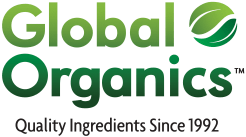Organic vs. Non-GMO: Key Differences
01.25.2016 | Author: Global Organics | Category: Organic & Sustainability, Quality & Certifications
No doubt you have heard about GMO labeling in the news recently. Sales of non-GMO products are growing faster than other label claims, including certified organic, yet consumers are confused about what many of these claims mean.
First, since genetic modification is not permitted in certified organic products, organic foods are by definition non-GMO. This doesn’t work the other way around; non-GMO does not mean organic. Organic certification involves so much more than the prohibition of genetic engineering. We’ve created the following chart to show some of the key differences:

Delving deeper into the issue, you will find that the highest volume GMO food crops in the US (corn and soy) were modified to tolerate the application of large amounts of chemical pesticides and herbicides. This widespread use of synthetic chemicals has been associated with biodiversity loss, water contamination, human health impacts and the evolution of superweeds/superpests with increased resistance to chemical applications. A treadmill effect has been created: farmers apply more and more chemical inputs to control superweeds/superpests, which were created by the widespread use of chemical inputs in the first place!
 The environmental impacts of organic agriculture look much better. Natural pest and weed control methods do not contribute to the rise of superweeds or superpests. Research has shown that organic farming methods can promote biodiversity, improve soil fertility and support water quality. For consumers, organic foods help reduce dietary exposure to pesticides and studies have shown they contain more nutrients than conventionally grown foods. Organic vs. Non-GMO? No contest…. Choose organic!
The environmental impacts of organic agriculture look much better. Natural pest and weed control methods do not contribute to the rise of superweeds or superpests. Research has shown that organic farming methods can promote biodiversity, improve soil fertility and support water quality. For consumers, organic foods help reduce dietary exposure to pesticides and studies have shown they contain more nutrients than conventionally grown foods. Organic vs. Non-GMO? No contest…. Choose organic!


